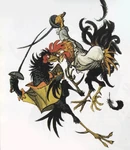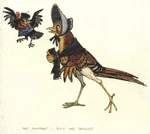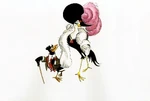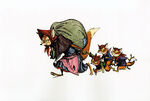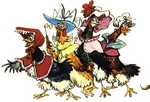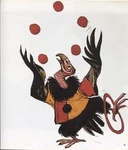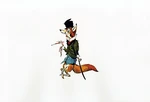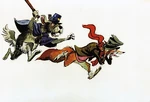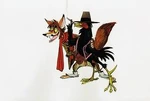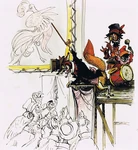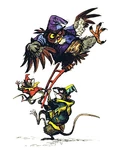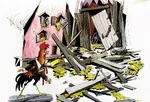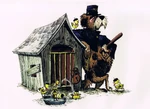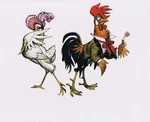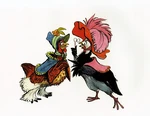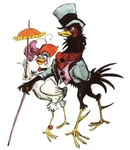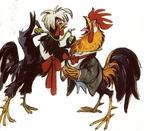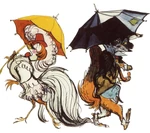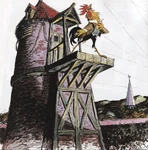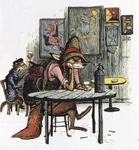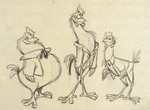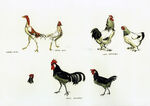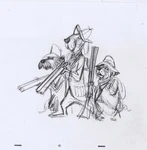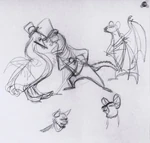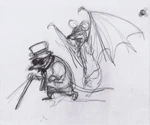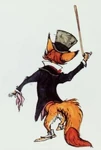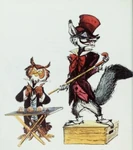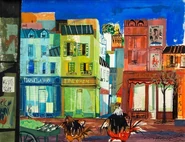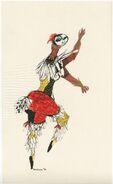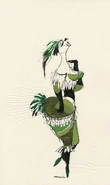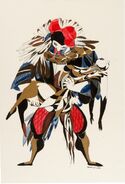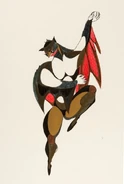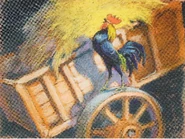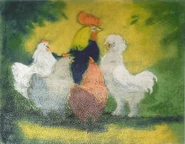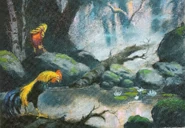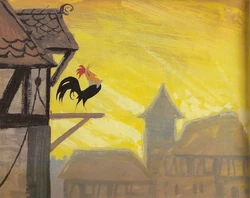
Concept art of Chanticleer crowing.
Chanticleer was a film based on the pre-WWI French play "Chantecler" by Edmond Rostand. Although it was in development at the Disney studio from the '40s up until the mid-'60s, it never saw completion.
Plot[]
Set on a Parisian farm in the late 1800s, much like the play, Chanticleer was to have been the story of a vain rooster whose leadership the other barnyard residents had accepted because they all truly believed his crowing was what brought the sun up each morning. Although, Chanticleer's power went to his head and he began acting bossy and demanding toward the animals, especially the hens who were made to lay copious amounts of eggs. Elsewhere, ruthless band of "Night Creatures" (e.g. moles, bats, vultures), headed by a vicious fox named Reynard were planning to seize the animals on the farm for their dinner. Under the guise of a traveling circus, they came to the farm and performed for the animals, causing them to want Reynard to lead them instead because unlike Chanticleer, he was allowing them to have fun. Elsewhere, a beautiful Pheasant who was new on the farm had constantly been trying to get Chanticleer to notice her, but all her attempts had failed. So Reynard, hoping that her beauty would distract Chanticleer so that the rooster couldn't ruin his plan, offered to give her a makeover. However, Chanticleer was to have eventually realized what the fox was up to, at which point the rooster was to have dueled one of Reynard's henchmen, a Spanish fighting cock known as Senior Poco Loco, during which time the sun would have risen without his crowing. At this, he would have realized the error in his vanity, found the strength to beat the cock and chased away the baddies for a happy ending.
Development[]
1940s[]
After both the financial and critical success of his first full-length animated feature Snow White and the Seven Dwarfs, Walt was always on the lookout for new material that his animators could adapt for the screen. In 1943, after "Chantecler" was brought to his attention, Walt told storymen Ted Sears and Al Perkins to see what they could do with the material. However, after they reported to him that they were in difficulties because they were unsure how to make a sympathetic character out of the titular rooster, Walt combined the project with that of "Reynard the Fox", another story animators were working on adapting at the time. This was because he thought that having a villain-in this case a fox to oppose Chantecler would help audiences sympathize with him. However, as with many of the studio's other feature films currently in development at the time, the project had to be shelved for the duration of WWII.
1960s[]
- “"The presentation didn't come off. The songs didn't gel, it was some guy up on a piano singing "cockadoodle doo! Cockaddoodle doo!" I sort of cringed in my chair. At the end of the whole thing Walt said: "I don't know guys, the rooster isn't a particularly appealing character. Not much warmth. Take a few days, see if you can come up with a different approach. ..."”
- “Larry Clemmons on the pitch meeting for Chanticleer'”
- ―{{{3}}}
After they had both finished their work on One Hundred and One Dalmatians, animators Marc Davis and Ken Anderson decided to collaborate in order to create a film in the wake of Broadway musicals. Going down to the Animation Archive Library, they both came across the Chanticleer concept art and liked what they saw. When Walt heard that they were going to pick up on the project, he advised them to scrap all previously attempted work and start fresh, hoping that they could get it done in this way. Although, Marc and Ken worked very hard for the next few months, creating lots of concept art, the other animators were more interested in Bill Peet's The Sword in the Stone because they also had the doubt that a rooster would be able to be sympathetic. On the other hand, the board of the studio, headed by Roy Disney was trying to convince Walt to halt production on animated features entirely so that he could put his finances toward his two Theme Parks. Though he would not agree to the former proposal, Walt did decide that one of the two projects currently in development at the studio would have to be shelved. The reason why The Sword in the Stone was kept over Chanticleer was because it was cheaper to animate humans than it was animals.
1980s[]
In 1981, Mel Shaw proposed a story treatment for Chanticleer that would depict the titular rooster as "the most macho chicken in all of France". However, it was quickly rejected by the then-heads of the studio for the same reason it had been in the past.
Music[]
The music for Chanticleer was composed by George Bruns. He had written three songs for the film which Mel Leven had lyricized.
They were as follows:
Chanticleer - Meant to open the film; the barnyard animals would've sung of how much they adored of their leader as they awoke in the morning.
You No Good Reynard - Meant to be sung by Reynard's wife as she berated her husband for never having given her and the kits a chance at a finer lifestyle despite promising to do so many times.
Yesterday is Over - Near the end of the film, when Chanticleer became worried that the other animals would ostracize him for never having held the power that he thought he did, the Pheasant would've sung this song to console him.
Legacy[]
Some of the character designs that Marc Davis produced for Chanticleer served as inspiration for the ones in Robin Hood. Some of the designs for the characters in America Sings were also inspired by them.
In 1991, Disney published a book based on the story treatment for Chanticleer entitled "Chanticleer and the Fox" that used Marc Davis's concept sketches for the illustrations. During the same year, Don Bluth, director of a rival studio who had worked a long time with Disney and subsequently knew about the deleted Chanticleer, did a movie named Rock-a-Doodle strongly inspired by Davis's works, but in which the story was set in 1950s Southern USA (Chanticleer was singing his "cock-a-doodle-doo" on a rock'n'roll music, for instance; hence the title, despite his appearance bearing of that to Elvis Presley). The film wasn't a total critical failure, mainly because of perfectly fine animation, but it was a total financial failure and it's mostly forgotten to this day.

